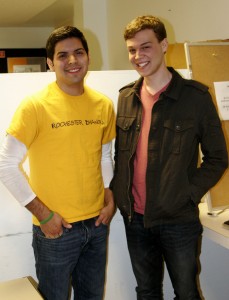Confronted with a packed agenda of pressing national issues, President Barack Obama gave a speech on Wednesday, Sept. 28 at a high school in Washington, D.C. that resonated with a single, powerful message to the nation’s students: Continue your education at all costs and to the highest possible level.
While funding to reinvigorate the nation’s strained public schools remains elusive in the gridlock of Washington, the issue of education inequality persists as a pressing concern for the nation’s stagnated economy and for the city of Rochester.
Taking up this pertinent cause and citing what they say is an astoundingly wide educational achievement gap in Rochester are two UR students — senior Trevor Baisden and sophomore Eduardo Quinonez — who are attempting to gain recognition from the Students’ Association for a chapter of the national organization Students for Education Reform (SEFR).
The organization, which has chapters at several prominent colleges and universities nationwide, describes their goals as threefold: raising awareness about educational inequality, advocating and lobbying for education reform polices and cultivating knowledge in undergraduate students to fight educational inequity by connecting them with internships and organizations working on the issue.
High school graduation rates in Rochester illuminate the vast disparities: The rate stands at 98 percent for Brighton High School, in comparison with a 54 percent graduation rate at East High School and a 50 percent rate at Jefferson High School. The Rochester district-wide rate is about 50 percent, and the New York state average is 74 percent.
“We know that intensive, targeted academic interventions work with students in the City School District,” said Beth Olivares, director of the David T. Kearns Center for Leadership and Diversity in Arts, Sciences and Engineering, which aims to expand educational opportunities to low-income and minority students.
Although Olivares stressed the success of several initiatives sponsored by the Kearns Center, including the Upward Bound program and the recent opening of the College Prep Center at East High School, she said that these programs can only serve a small number of students and are limited in their ability to address the large amount of need.
Baisden and Quiñonez have been amassing a group of students to form the core of what could be UR’s chapter of the advocacy group, and this week met with a staff member in the Wilson Commons Student Activities Office and submitted the group’s proposal to the SA Senate Policy & Review Committee.
“The University generally frowns upon student groups that are viewed as extensions of national agendas, so it will be important to demonstrate that the SFER at UR is not a cookie-cutter copy of every other chapter nationwide,” Baisden said. “However, it shouldn’t be a tough sell because every chapter truly is unique.”
Baisden also said his personal experiences have made the cause particularly relevant to him.
“I was blessed with the opportunity to attend UR,” he said. “The reality is that this opportunity is simply not available for far too many students growing up right here in Rochester, and it’s not their failure.”
Quiñonez also said that he believes education is “one of the most important things that we can give our younger generations at the K-12 level” and something that “we should invest more resources in.”
Baisden and Quiñonez, who said that so far about a dozen students have expressed interest in developing an E-board and getting the initiative off the ground, currently do not have a group advisor from the school, but said they are working toward this and think recognition from UR will allow them to advertise in more traditional ways and garner student participants and supporters.
Meanwhile, they have reached out to groups with comparable goals on campus, such as Partners in Reading (PiR), a community service group on campus that sends UR students to tutor in low-income school districts in Rochester.
Baisden said such efforts have been instrumental to their recruiting process, but the main thrust of SFER in the future will be advocacy for issues and policy change.
The two students aim to conduct events this academic year such as screening movies related to education, hosting panels of professors and speakers and conducting phone banks to spur policy change.
President of PiR Michelle Giwerc said she thinks it is “immensely obvious” that the Rochester City School District is in need of “some major reform,” and that an organization like SFER is a “necessity” for both the UR and the city of Rochester.
“As college students, we get so incredibly wrapped up in our own lives,” she said. “I’m not sure if there’s a large population of UR students who actually feel a real connection to the city of Rochester. I know that our students would have a greater appreciation of and love for Rochester if they understood the issues that are going on.”
She emphasized, though, that the first step in making any impact on educational inequality is getting involved.
Junior Emily Kasman, a PiR member, also said she sees the necessity of the cause and that she thinks the problem of educational inequality has grown to such exponential proportions that “it’s hard to know where to begin to attack it.” She believes groups like PiR, unfortunately, have limited impact, as there is only “so much time we can spend at the school during the week.”
“I think that [Students for Education Reform] has the potential to be quite successful if done right,” she said. “The advocacy group would hopefully make other students aware of the importance of what PiR does and inspire them to join or take action in other ways.”
Additional reporting by Emily Berkowitz, who is a member of the class of 2012.
Buletti is a member of the class of 2013.



